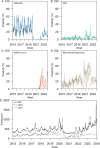Excess Respiratory Hospitalisations Associated with Influenza, Respiratory Syncytial Virus and SARS-CoV-2 in Singapore from 2015 to 2023
- PMID: 40196916
- PMCID: PMC11976161
- DOI: 10.1111/irv.70098
Excess Respiratory Hospitalisations Associated with Influenza, Respiratory Syncytial Virus and SARS-CoV-2 in Singapore from 2015 to 2023
Abstract
Background: The patterns of circulation and burden of influenza and respiratory syncytial virus (RSV) in Singapore are affected by the COVID-19 pandemic containment measures. These patterns in relation to SARS-CoV-2 in a post-pandemic era are unclear.
Methods: Using data from 2015 to 2023, we estimated excess influenza-, RSV- and SARS-CoV-2-associated hospitalisation in Singapore, adjusted for rhinovirus/enterovirus activity in generalised additive models. The data include pneumonia and influenza (P&I) hospitalisation from a national inpatient database and a community-wide acute respiratory infection (ARI) sentinel surveillance programme, stratified by age groups.
Results: Across all age groups, the proportion of hospitalisation associated with influenza, SARS-CoV-2 and RSV was 13.2% (95% CI 5.0%-21.6%), 19.3% (95% CI 13.8%-25.0%) and 4.0% (95% CI 0.9%-12.1%) in 2023, respectively. From 2019 to 2023, all-age influenza-associated hospitalisation declined from 264.4 per 100,000 person-years (95% CI 214.2-313.2) to 203.7 per 100,000 person-years (95% CI 76.8-333.6). In contrast, all-age RSV-associated hospitalisation after the pandemic was 62.2 per 100,000 person-years (95% CI 13.8-186.9), similar to pre-pandemic observations. Peak seasonal influenza occurred 3-8 weeks later as compared with the time of pre-pandemic peak influenza activity.
Conclusion: The overall burden of influenza has declined after the COVID-19 pandemic and its burden is comparable with SARS-CoV-2. Furthermore, shifts in the timing of peak influenza activity suggest a potential need to review the timing of vaccine recommendations in Singapore.
Keywords: RSV; SARS‐CoV‐2; Singapore; hospitalisation; influenza; respiratory.
© 2025 The Author(s). Influenza and Other Respiratory Viruses published by John Wiley & Sons Ltd.
Conflict of interest statement
The authors declare no conflicts of interest.
Figures

References
-
- Bender R. G., Sirota S. B., Swetschinski L. R., et al., “Global, Regional, and National Incidence and Mortality Burden of non‐COVID‐19 Lower Respiratory Infections and Aetiologies, 1990–2021: A Systematic Analysis From the Global Burden of Disease Study 2021,” Lancet Infectious Diseases 24 (2024): 974–1002. - PMC - PubMed
-
- Staadegaard L., Del Riccio M., Wiegersma S., et al., “The Impact of the SARS‐CoV‐2 Pandemic on Global Influenza Surveillance: Insights From 18 National Influenza Centers Based on a Survey Conducted Between November 2021 and March 2022,” Influenza and Other Respiratory Viruses 17 (2023): e13140. - PMC - PubMed
-
- Riccio M. D., Caini S., Bonaccorsi G., et al., “Global Analysis of Respiratory Viral Circulation and Timing of Epidemics in the Pre–COVID‐19 and COVID‐19 Pandemic Eras, Based on Data From the Global Influenza Surveillance and Response System (GISRS),” International Journal of Infectious Diseases 144 (2024): 107052. - PubMed
MeSH terms
LinkOut - more resources
Full Text Sources
Medical
Miscellaneous

